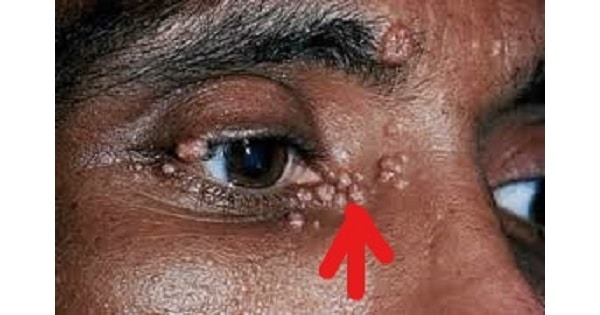Question
The inflammatory disorder of eyelid as shown in the photograph below is caused by ?

A. Bacteria.
B. Fungus.
C. Protozoa.
D. Virus.
Show Answer
|
Correct Answer » D Explanation |
 |
Ans:D. Virus.
The condition as shown in the picture above represents Molluscum contagiosum.
Molluscum contagiosum
- It is a viral infection of the skin and occasionally of the mucous membranes.
- MC can affect any area of the skin, but is most common on the trunk of the body, face,arms, groin, and legs.
- It is caused by a DNA poxvirus called the molluscum contagiosum virus (MCV).
- Transmission of the molluscum contagiosum virus can occur many different ways including direct skin contact (e.g., contact sports or sexual activity), contact with an infected surface (fomite), or autoinoculation (self-infection) by scratching or picking molluscum lesions and then touching other parts of the skin not previously affected by the virus .
- It is most common in children aged one to 11 years old.
- It causes characteristic skin lesions consisting of single or, more often, multiple, rounded, dome-shaped, pink, waxy papules that are 2-5 mm (rarely up to 1.5 cm in the case of a giant molluscus) in diameter. The papules are umbilicated and contain a caseous plug.
- MC is a recognised ocular complication of acquired immune deficiency syndrome and has been
- reported in patients undergoing systemic steroid treatment.
- The eyelid is the most common site of ocular lesions, although conjunctival lesions have been reported.
- Chronic conjunctivitis or keratoconjunctivitis can be associated with eyelid lesions
Treatment
- In healthy patients, molluscum contagiosum is generally self-limited and heals spontaneously after several months.
- Topical creams containing Tretinoin, cantharidin, and imiquimod ,salicylic acid ,trichloroacetic acid.
- In immunocompromised patients, improvement of lesions has been observed in individual patients treated with ritonavir, cidofovir (intravenous and topical), and zidovudine. Patients with AIDS and severe molluscum contagiosum improve with effective antiretroviral therapy.
Extirpation:Curettage .
